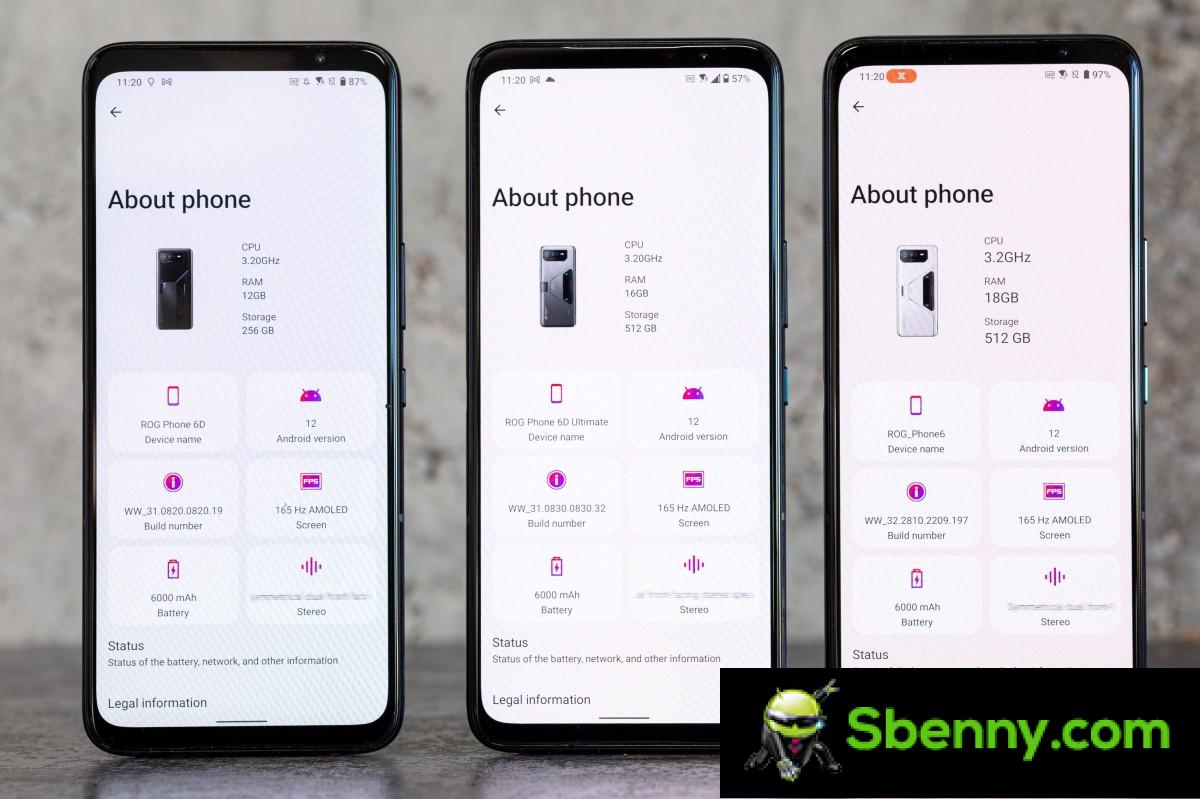introduction
We recently reviewed both the ROG Phone 6 Pro and the ROG Phone 6D Ultimate. As you may already know, the former is based on Qualcomm’s Snapdragon 8+ Gen 1 chipset, while the latter uses an optimized version of MediaTek’s Dimensity 9000+ chipset. The ROG Phone 6D Ultimate also has the unique Asus AeroActive Portal on the back: an active air duct with thin thermal fins and a direct path into the phone’s internal cooling. It’s intriguing hardware we’ve already tested in our 6D Ultimate review.

Today we turn our attention to the vanilla ROG Phone 6D, the non-Ultimate model. Just like its 6D Ultimate sibling, it is based on the Dimensity 9000+ chipset. Unlike him, however, it lacks the AeroActive portal, which means that, at the very least, there are some thermal management differences between the two. Since this and the absence of a ROG Vision display on the back of the ROG Phone 6D are the only differences to note between the vanilla and the Ultimate, we won’t be doing a full review. It would be very redundant, to say the least. What we’ll do, however, is compare the ROG Phone 6D and test its thermal throttling behavior to see how it compares to its sibling, which would answer the question of which ROG Phone 6 is the best performing.
synthetic benchmarks
Before going into reference numbers, some additional information is needed. The ROG Phone 6D unit we have for testing is the Batman Special Edition. Just like his brother Ultimate, he has an essentially overclocked MediaTek Dimensity 9000+ chipset. Users get a single primary Cortex-X2 core, clocked at up to 3.35 GHz instead of the default 3.2 GHz. The three Cortex-A710 cores are also overclocked to 3.20 GHz instead of the default 2.85 GHz. The remaining four “small” Cortex-A510 cores are left at their default 1.8 GHz, which makes sense to see how they are designed for efficiency rather than performance.

In terms of GPU, the ROG Phone 6D and 6D Ultimate are both rocking the Mali-G710 MC10 without mentioning an overclock of any kind. The chipset is paired with 256GB of UFS 3.1 storage and up to 16GB of RAM, which seems odd at first, as ROG Phone 6 Pro offers up to 18GB of RAM. However, ROG Phone 6D and 6D Ultimate use the latest LPDDR5X RAM, which currently only comes in 16GB modules, which explains the decision. Our particular Batman unit, however, is not the top tier model, so it has 12GB of RAM available.
We’ll be the first to admit that the ROG Phone 6D benchmark scores are predictable, but we won’t hear any complaints about consistency compared to the ROG Phone 6D Ultimate.
The CPU performance of the MediaTek Dimensity 9000+ is clearly better than the Snapdragon 8+ Gen 1 inside the ROG Phone 6 Pro, especially in the multi-core test, where the former achieved more than 30% higher performance in the default dynamic mode .
In the single-core part of the test, the ROG Phone 6 Pro took the lead until X-Mode was activated. Obviously, Asus managed to fine-tune X-Mode on the Dimensity 9000+ very well.
GeekBench 5 (multi-core)
Higher is better
-
ROG 6D phone (X + mode)
4631 -
ROG 6D phone (X mode)
4586 -
ROG 6D Ultimate Phone (X + Mode)
4575 -
ROG 6D Ultimate Phone (X Mode)
4528 -
Asus ROG Phone 6 Pro (X + mode)
3980 -
Asus ROG Phone 6 Pro (X mode)
3889 -
ROG 6D phone
3531 -
ROG 6D Ultimate phone
3505 -
Asus ROG Phone 6 Pro
2659
GeekBench 5 (single-core)
Higher is better
-
ROG 6D phone (X mode)
1402 -
ROG 6D phone (X + mode)
1399 -
ROG 6D Ultimate Phone (X Mode)
1374 -
ROG 6D Ultimate Phone (X + Mode)
1360 -
Asus ROG Phone 6 Pro (X + mode)
1329 -
Asus ROG Phone 6 Pro (X mode)
1300 -
Asus ROG Phone 6 Pro
1110 -
ROG 6D phone
1015 -
ROG 6D Ultimate phone
1001
AnTuTu seems to offer a little more “spread” in scores at first glance, but once you get to the point, the variances are still well within the margin of error from run to run and ROG Phone 6D and 6D Ultimate swap blows in the three different modes. The ROG Phone 6 scores surprisingly low in the default dynamic mode, but resumes its position once X mode is activated.
Apparently, the ROG Phone 6D’s 12GB of RAM didn’t turn out to be a major drawback in AnTuTu.
AnTuTu 9
Higher is better
-
ROG 6D Ultimate Phone (X + Mode)
1107464 -
ROG 6D phone (X + mode)
1104042 -
Asus ROG Phone 6 Pro (X + mode)
1103188 -
Asus ROG Phone 6 Pro (X mode)
1094300 -
ROG 6D phone (X mode)
1089220 -
ROG 6D Ultimate Phone (X Mode)
1085829 -
ROG 6D phone
948594 -
ROG 6D Ultimate phone
931170 -
Asus ROG Phone 6 Pro
762090
Moving on to the graphics benchmarks, we find another batch of consistently similar scores. Again, the ROG Phone 6 scores the lowest in both GFX Aztek tests, but gets back on track as soon as X mode is activated.
GFX Aztek ES 3.1 High (on screen)
Higher is better
-
ROG 6D Ultimate Phone (X + Mode)
63 -
ROG 6D Ultimate Phone (X Mode)
62 -
ROG 6D phone (X mode)
62 -
ROG 6D phone (X + mode)
62 -
Asus ROG Phone 6 Pro (X mode)
61 -
Asus ROG Phone 6 Pro (X + mode)
61 -
ROG 6D phone
61 -
ROG 6D Ultimate phone
59 -
Asus ROG Phone 6 Pro
58
GFX Aztek Vulkan High (on screen)
Higher is better
-
Asus ROG Phone 6 Pro (X + mode)
66 -
Asus ROG Phone 6 Pro (X mode)
65 -
ROG 6D Ultimate Phone (X Mode)
64 -
ROG 6D Ultimate Phone (X + Mode)
64 -
ROG 6D phone
64 -
ROG 6D phone (X + mode)
64 -
ROG 6D Ultimate phone
63 -
ROG 6D phone (X mode)
63 -
Asus ROG Phone 6 Pro
56
As we move further down the benchmark stack, we come to less difficult tests using older versions of the graphics API. This is where we notice that the ROG Phone 6 Pro with Snapdragon 8+ Gen 1 scores higher than its MediaTek siblings.
The differences are insignificant, but it appears Qualcomm’s chip is better optimized for older versions of OpenGL ES, for what it’s worth.
GFX Car Chase ES 3.1 (on screen)
Higher is better
-
Asus ROG Phone 6 Pro
79 -
Asus ROG Phone 6 Pro (X mode)
79 -
Asus ROG Phone 6 Pro (X + mode)
79 -
ROG 6D phone (X mode)
77 -
ROG 6D phone (X + mode)
76 -
ROG 6D Ultimate phone
72 -
ROG 6D Ultimate Phone (X Mode)
72 -
ROG 6D Ultimate Phone (X + Mode)
72 -
ROG 6D phone
71
GFX Manhattan ES 3.1 (on screen)
Higher is better
-
Asus ROG Phone 6 Pro (X + mode)
140 -
Asus ROG Phone 6 Pro (X mode)
139 -
Asus ROG Phone 6 Pro
126 -
ROG 6D Ultimate Phone (X Mode)
124 -
ROG 6D Ultimate Phone (X + Mode)
124 -
ROG 6D phone (X mode)
124 -
ROG 6D phone (X + mode)
123 -
ROG 6D Ultimate phone
122 -
ROG 6D phone
122
Either way, we’re quickly starting to get numbers well above 100fps, which is hard to complain about in these synthetic and unrealistically difficult loads. Any modern game engine will be much more flexible when it comes to rendering to ensure high frame rates.
Also, it’s no surprise that what are arguably some of, if not the best, gaming phones currently out there can render many frames and chew on just about any task thrown at them.
Finally, the 3DMark Wild Life Extreme test paints the same picture as the last two tests, hinting at the Snapdragon 8+ Gen 1.
3DMark Wild Life Extreme (1440p off screen)
Higher is better
-
Asus ROG Phone 6 Pro (X + mode)
2815 -
Asus ROG Phone 6 Pro (X mode)
2814 -
ROG 6D Ultimate Phone (X + Mode)
2668 -
ROG 6D Ultimate Phone (X Mode)
2634 -
ROG 6D phone (X + mode)
2622 -
ROG 6D phone (X mode)
2621 -
Asus ROG Phone 6 Pro
2611 -
ROG 6D Ultimate phone
2599 -
ROG 6D phone
2555
Overall, the two MediaTek Dimensity 9000+ phones – the ROG Phone 6D and 6D Ultimate – snatch the win in the performance section of the test. Asus and Mediatek did a great job fine-tuning the MediaTek chipset. The ROG Phone 6D is no slouch even though it has “only” 12GB of RAM. We’ll be keeping an eye on it in the thermal limiting section of our test to see if it can hold up as well as the 6D Ultimate and its AeroActive Portal.
Thermal limiting behavior
In the second part of our test, we’ll take a look at the thermal throttling behavior of the three ROG 6 phones during an hour of running the aptly named CPU Throttling benchmark, as well as a 20-minute run of 3D Mark test’s Wild Life Extreme, which requires more GPUs as it loops Vulkan 1.1 based 3D tests off screen at 1440p resolution.
Entering the test, we expected ROG Phone 6 Pro to perform best with its Snapdragon 8+ Gen 1 chipset.
The 6D Ultimate AeroActive Portal only activates after connecting the AeroActive cooler to the back of the phone, i.e. when X Mode + can be activated.
So in the default dynamic mode and the lower X mode, we expected the two 6D phones to behave similarly.
Dynamic mode
Let’s start with the ROG Phone 6D in the default dynamic mode. The vanilla 6D showed the smallest performance limitation of the three phones, but the other two started out with much higher peak performance numbers, with the 6 Pro leading the pack. This behavior leads the 6 Pro and the 6D Ultimate to have lower average performance than the 6D within 1 hour of testing.
As you see, the 6D and the 6D Ultimate seem to be tuned differently. We’re also seeing a startling variation from what was seen in the CPU-bound Geekbench result, where the two 6D phones scored the same.



Dynamic Mode: ROG Phone 6D • ROG Phone 6D Ultimate • ROG Phone 6 Pro
The 3DMark test paints the same image, although there is much less difference in performance. The ROG Phone 6 Pro leads the pack in the 3DMark test regardless of performance mode.



Dynamic Mode: ROG Phone 6D • ROG Phone 6D Ultimate • ROG Phone 6 Pro
X mode without the AeroActive Cooler connected
Switching to X mode without the AeroActive cooler attached.
Here, we see another great performance from the vanilla ROG Phone 6D. It also had the highest peak performance of the three phones in the CPU throttling test.
The winner with X Mode ON, however, was the ROG Phone 6 Pro which achieved the highest average score and highest minimum performance score in the CPU Throttling test. It also had the highest 3D Mark score and the least throttling of the three devices.
The ROG 6 Ultimate had the biggest drop in performance and a much more indented line of performance. It’s probably not jagged enough to be perceived as a stutterer in real life, but it’s still a noticeably different behavior from the other two phones.



X mode without cooler: ROG Phone 6D • ROG Phone 6D Ultimate • ROG Phone 6 Pro



X mode without cooler: ROG Phone 6D • ROG Phone 6D Ultimate • ROG Phone 6 Pro
X Mode + with the AeroActive Cooler 6 connected
Finally, we need to look at ROG phones in their state of top performance: X Mode + with an AeroActive Cooler 6 plugged in at full blast, which Asus calls “Frozen” mode. This is intended to give the chipset and cooling configuration the best chance to impress.
The winner here is once again the ROG Phone 6 Pro with the highest scores across the board – its maximum, average and minimum scores are better than what the 6D Ultimate could garner, it is also the top device in the stress test of 3D Mark.
The ROG Phone 6D Ultimate scores the lowest although the margin isn’t as wide as in the previous test in X mode. Overall, it’s a solid demonstration, but we’re a little surprised it couldn’t beat the vanilla 6D despite the integrated AeroActive Portal, which in theory should improve cooling.
The ROG Phone 6D performs remarkably well in this test round. It didn’t have the maximum peak performance in the CPU Throttling test (by a really small margin), but it beat the 6D Ultimate with its average and minimum scores, which are what count in a thermal throttling test like this one.



X Mode + with cooler: ROG Phone 6D • ROG Phone 6D Ultimate • ROG Phone 6 Pro
The ROG Phone 6D also performed identically to the 6D Ultimate in the 3D Mark stress test, both in terms of scores and stability, although it lacks the Aeroactive Portal of the more expensive model.



X Mode + with cooler: ROG Phone 6D • ROG Phone 6D Ultimate • ROG Phone 6 Pro
Conclusion
In performance benchmarks, the ROG Phone 6D has proven to have identical performance to the ROG Phone 6D Ultimate. After all, both phones share pretty much the same hardware, with the Asus-optimized MediaTek Dimensity 9000+ chipset at the helm.
They also have better benchmark scores than the ROG Phone 6 Pro, with the exception of the older OpenGL benchmarks, where the Snapdragon 8+ Gen 1 takes its lead back.

But perhaps the biggest surprise in this comparison test was that when it comes to thermal throttling behavior, the vanilla 6D performed better or as well as the ROG Phone 6D Ultimate in all three performance modes. Not only that, but it stood up to the 6 Pro.
However, it appears that the Mediatek chips are more prone to heat up than the Snapdragon 8+ Gen 1 when pushed harder as the Snapdragon chipset held cool in the GPU stress test.
Verdict
When we come to the end of this comparative test, it’s time to deliver a verdict. If we had to choose a single device out of the three, we recommend buying the vanilla ROG Phone 6D. It’s only available in the 12GB / 256GB configuration, but we didn’t find 12GB RAM to be a bottleneck in any of the benchmarks. It also doesn’t have a screen on the back, but ROG Phone 6 Pro and 6D Ultimate will cost you around 30% more without providing any significant performance gains.
The two 6D models are still in pre-order, but if you’re not in a rush with your purchase, we’d say the ROG Phone 6D is the cheapest and most sensible entry in the ROG Phone 6 series.







Start a new Thread